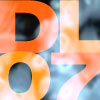(JB) A couple of lines more on two other films from yesterday's opening. George Drivas' “Case Study” from 2007 is a refreshingly low-key take on surveillance and today's cities. Or tomorrow's, actually, as “Case Study” belongs to the genre of science fiction which relies on the futuristic qualities of whatever is surrounding us right now rather then constructing a projection of a possible future. Think along the lines of Nouvelle Vague Sci-Fi like Truffaut's Fahrenheit 451 or Godard's Alphaville, and of course Chris Marker's seminal La Jetée from 1962. Like Marker's film, “Case Study” is told through a series of black & white photographs.
George Drivas GR Case Study 2007, 17 min International premiere
Instead of a character-driven narrative, Drivas relies on the ornamental or abstract qualities of Berlin's architecture, using landmarks like Hugh Stubbins' wonderful modernist Congress Hall or the abysmal pseudo-post-whatever Alexa Centre, which, to my surprise, blend into a very homogeneous, beautiful & unique non-place (I suppose that the lack of colour really helps in the Alexa's case). While we basically follow the path of the protagonists through a multitude of halls, stations and staircases, there is no obvious distinction between separate buildings; the space traversed by the people in Drivas' film is not meant for anything else than transit.
Obviously, this goes well with the surveillance topic, as surveillance is to large extents based on the localization of persons within space; thus, the pristine transit spaces of Drivas' film, purged of any other connotations, make the actuality of following and being followed even more poignant. Thankfully, Drivas also abstains from the popular (or populist) polemics used by most artists working on surveillance issues. Analogous to the reduction of the city to a pure means of transit, surveillance is reduced to the acts of being watched and followed. No specific antagonism – the state watching the people, the corporations watching the people, the police watching the people – is needed here; all that's left is the both abstract and highly emotional state watching someone being watched, and, of course, participating in the “Case Study” as a viewer ourselves.
Some more notes on architecture; obviously, modernist architecture and its successors have created a very distinct tradition of fear, opposed to the fear evoked by historical or traditional architecture, which usually is connected to the notion of the past, the suppressed or the hidden; think of the house of Norman Bates and his deceased mother. Interestingly, the often-heard critique of modern architecture as inhumane stands in stark contrast with the humanist concepts of modernity itself, and has produced quite a lot of misunderstandings and outright tragedies, usually symbolized in the very concept of “social housing” (you might want to check out the Candyman movie and the sad truth behind its setting for a particularity gruesome entry into the topic).
Judy Schlesinger, female lead of Flash by André Werner with sound supervisor Daniel Schubert
Let's stay on the darker side for a while. As I have worked on modern horror cinema for my MA thesis, André Werner's “Flash” (2008) seems a bit too close to home. Nevertheless, this is a very witty pastiche of modern horror techniques (especially, as the title suggests, the lighting) and trappings in just about 15 minutes. As far as I noticed, each of the base ingredients was included – the nuclear family, the possessed child, the animal, the locked doors, the archive, the asylum, the secret experiment ... well, it might have lacked the stooped figure with her face hidden by long hair, but I'll have to take a closer look during the second screening next Wednesday. It's sure to be there, somewhere. The fun part is that every element might be read in various ways to get one of n possible coherent narratives – you just have to re-build the missing links between the ingredients. So, what was the thing with the dog about, now?
See you this evening for what looks as about fifty more films -
Best, JB



 Spree Getraenke
Spree Getraenke











0 Comments:
Post a Comment